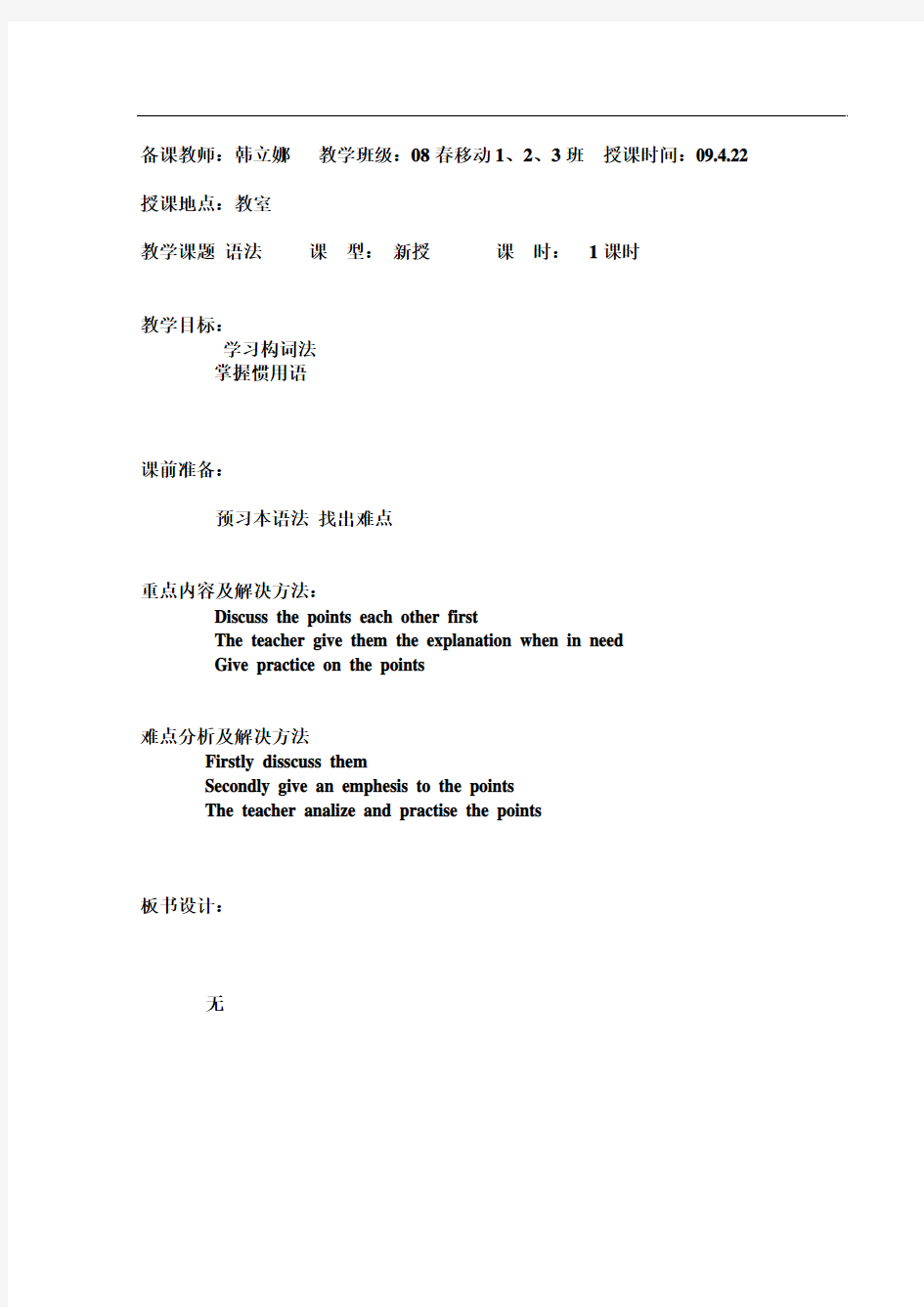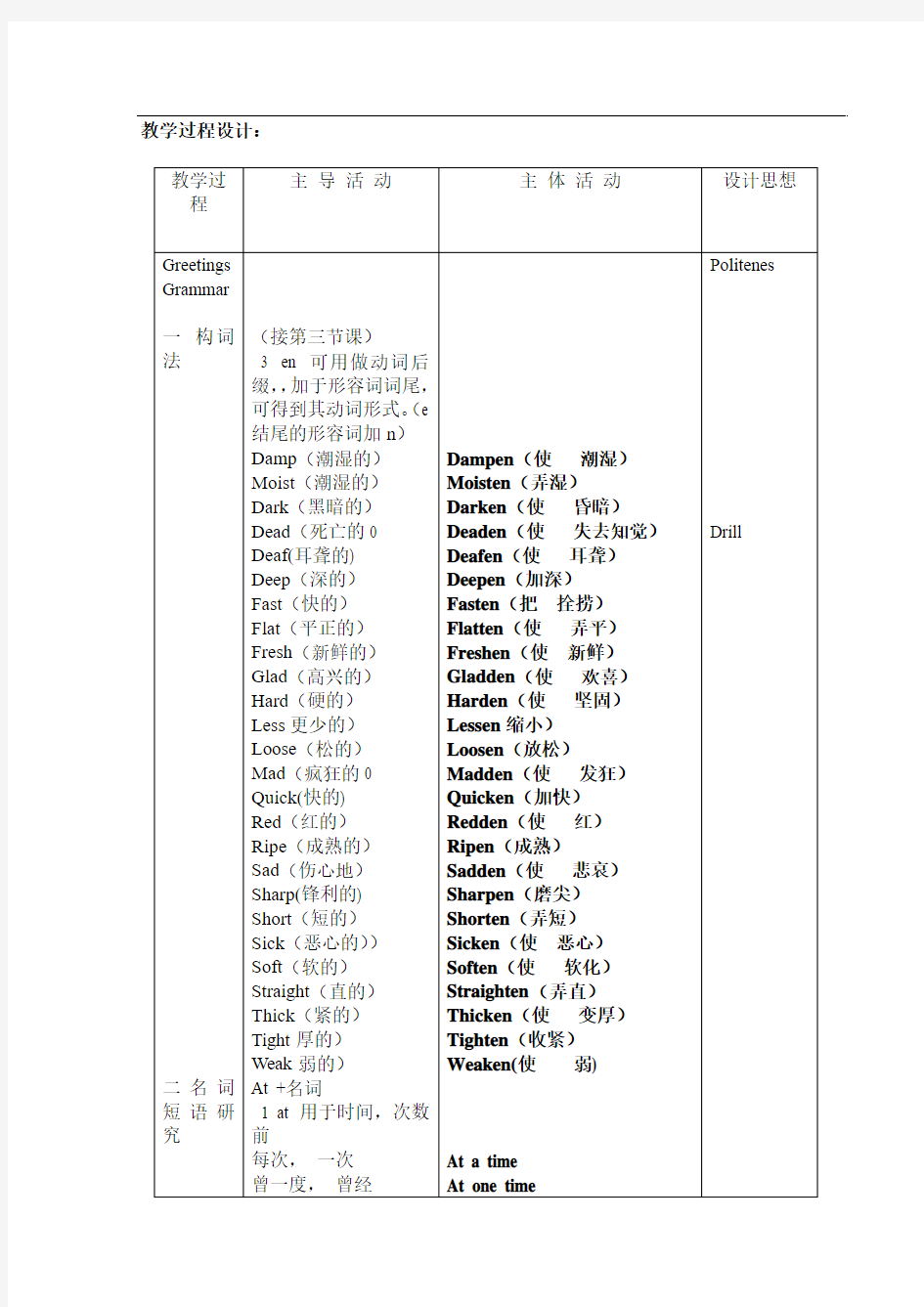构词法3


备课教师:韩立娜教学班级:08春移动1、2、3班授课时间:09.4.22 授课地点:教室
教学课题语法课型:新授课时:1课时
教学目标:
学习构词法
掌握惯用语
课前准备:
预习本语法找出难点
重点内容及解决方法:
Discuss the points each other first
The teacher give them the explanation when in need
Give practice on the points
难点分析及解决方法
Firstly disscuss them
Secondly give an emphesis to the points
The teacher analize and practise the points
板书设计:
无
教学过程设计:
最新初中英语常用构词法归纳
英语专题讲座(一) 词汇的分类和构词法 一、复习要点阐述 我们学习的语言的每一篇文章都是由句子构成的。每一个句子都是由或多或少的词构成的。单词是语言构成的最基础内容,教英语的老师通常会说“一个学生记住的词汇是与他的英语成绩成正比。”这句话说明了一件事,就是词汇量的重要性。就像我们自己的国语中文,一个孩子从小到大,在日常生活中记住了大量的词汇,所以运用起来很自如。如何能记好英语的单词及其他们的用法,了解英语的词类和构词法对于一个考生来说是很重要的。所以在今天的专题中,我们将复习英语的词类和初中阶段我们所要掌握的几种构词法,使同学们对英语的词类及其简单的用法有一定的了解,并能正确的使用词汇。 二、要点复习的策略及技巧 (一)英语的词类 英语中的词类根据其语法功能分为名词、冠词、代词、数词、副词、介词、连词、感叹词、动词十类。根据意义又可以分为实词和虚词。实词指具有实际意义并能单独作句子成分的词。这些词是名词、数词、代词、形容词、副词和动词六类。虚词指没有实际意义或实际意义不明显、不能在句子中单独作句子成分的词。这些词是冠词、介词、连词和感叹词四类。 下面我们就词汇的分类、名称、作用及例词列表。
从上面的表格中我们简要地讲解了英语十大词类的基本用法。同学们可以仔细的体会一下此表的内容。这将有助于你们对句子和文章的理解。 (二)构词法 语言的基本要素之一是词汇。在语言发展的最初阶段,人们使用的是少量而简单的词汇,这些词汇只表示日常简单的事物和概念,构成语言最基本的词,称为原生词,也叫基本词或词根词。英语里的原生词大都是单音节的。如:sun, man, head, foot, fish, see, run等,其数量是有限的。随着社会的发展与进步,语言的扩充与融合使语言变得复杂,原有的原生词已不够用,人们便创造了一些新词来表示新有的事物与概念,按照语言一定的规律创造新词的方法,就是我们所说的构词法。在初中阶段我们学习了下列构词法,了解了这些构词法,我们对词的用法就更方便一些。 1. 合成法 合成法至今保持着旺盛的生命力,在现代英语中不少新词都是借助原有的词合成的。 1)名词+名词→名词 basket(篮子)+ball(球)→basketball篮球book (书) +shop(商店) → bookshop书店 book(书) + store(商店) → bookstore书店house(房子) +work(劳动) → housework家务劳动 home(家庭) + work(工作) → homework家庭作业 2) 形容词+名词→名词 black(黑色的)+board(木板)→ blackboard黑板English(英国的)+man(人)→ Englishman英国人 loud(大声的)+speaker(说话者) → loudspeaker扬声器 3)动词的-ing形式+名词
关于英语构词法的论文
浅谈运用构词法记英语单词 摘要 随着全球化进程的加快,互联网的普及,国际交往的增多,越来越多的词汇进入英语语言。有语言学家预言,在不久的将来,英语词汇量将超过1,000,000,学习者要想顺利地阅读英语文学作品、报刊等至少需要掌握10,000个英语单词。那么有没有什么方法能够科学、高效地记忆英语单词呢?本篇文章介绍了构词法中,最常见的几种记忆词汇的方法。要学好英语就必须掌握大量的词汇,要掌握大量词汇就要求我们关注词汇的组合规律,发现词的发音和拼写特点,寻找音和形之间的联系;了解构词法的知识,从而提高我们记单词的效率,这已经形成了共识。 关键词:构词法记忆单词 1
Abstract With the proceedings of globalization, the popularization of Internet, the increase of international association, more and more words came into the English language. Some linguists utter a prediction: in the near future, English vocabulary will be more than one million. If learners want to read English literary works and newspapers smoothly, he must grasp at least 10,000 English words. So what method can scientifically and effectively to remember new English words? This article introduces the most of several common word-formation methods. It is necessary to have a large vocabulary if you want to learn English well. And you must concern word-formation law, found the words pronunciation and spelling characteristics,and the connection between the sound and shape. Understand the knowledge of word-formation can help us memorize new words efficiently, which has formed a consensus. Key Words:word-formation law memorize word 2
构词法
构词法 一、掌握构词法的重要性 1.有助于扩大词汇 care careful careless carefully carelessly carelessness carefulness 2.有助于了解词义 possible impossible fair unfair 3.有助于辨认词类 glory glorious operate operation 二、英语的构词方法 在英语中,主要有三种构词法,即合成、转化和派生。 1.合成由两个或两个以上的词结合成一个新的词的方法称作合成法。用这种方法构成的词,叫合成词。合成词有的用连字符―-‖连接,有的直接连写在一起。合成词的词类主要有三种,即合成名词、合成形容词和合成动词。 1)合成名词 football birthday homework blackboard dining-room drinking-water 2)合成形容词 middle-aged warm-hearted ordinary-looking funny-looking hard-working 2.转化由一种词类转化成另一种或几种词类的方法称作转化法. 1)由名词转化为动词,例如: water n. 水→water v. 浇水 2)由形容词转化为动词,例如: clean adj.干净的→clean v.打扫,清理empty adj. 空的→empty v.清空,倒空 3.派生由一个词根加上前缀或后缀构成另一个词的方法称作派生法。前缀附加在单词或词根的前面,一般不改变原词的词类,但引起词义的变化;后缀附加在单词或词根的后面,一般不改变原词的基本含义,只改变词类。 1)常见的前缀 (1)用来构成反义词的前缀 ①dis- agree 同意disagree __________; appear 出现disappear ________ like 喜欢dislike honest诚实的dishonest _______ ②in- complete 完全的incomplete__________; correct 正确的incorrect___________ ③im- 例如: possible 可能的impossible ______ ;polite 有礼貌的impolite _____________ ④ir-例如: regular 规则的irregular ___________________ ⑤il-例如: legal合法的illegal Driving after wine breaks the law, that is to say, it is illegal. ⑥un- fair 公正的unfair __________; happy高兴的unhappy _________ ⑦non-例如: stop 停止non-stop __________;smoker 吸烟者non-smoker ___________violent→non –violent________ ⑧ab-例如:normal正常的→abnormal 反常的use使用→abuse 滥用absent= not present 缺席 Don’t abuse drugs and you should have a healthy lifestyle.
高三英语构词法重点专题构词法归纳知识点分析
重点专题构词法归纳 1.派生法 (1)前缀 ①表示否定意义的前缀: a. 纯否定前缀: un-: unable, unemployment(失业), unload(卸载), uncover(揭开), unhappy, untrue, unlike (不像), unrest(不安的,动荡的), unfair, unknown, unhealthy, unusual, uncertain, unclear(不清楚的), unequal, unlucky, unreal, unkind, uncomfortable, uneasy(心情不安的), uninteresting, unimportant, unnecessary, unpleasant, undivided, unreserved(无保留的) dis-: dislike(不喜欢), disarm, disconnect, disagree, disappear, disadvantage, dishonest, disability, discover(发现), disobey in-, im-, il-, ir-: incapable, inability, incomplete, incorrect, inconvenient, inexpensive, impossible, immoral(不道德的), illegal(非法的), illogical(不合乎逻辑的), irregular, irrelative non-: non-smoker, non-stop, non-violent(非暴力的), nonwhite, non-member, nonparty(无党派), nonsense(无意义) b. 表示错误的意义: mis-: mistake, mislead(误导), misunderstanding, misuse, mis-spell, mistrust, mistreat c. 表示“反、防、抗”的意义: anti-: antiknock(防震), antiforeign(排外的), anti-war, antitank(反战车的), anti-pollution ②表示空间位置、方向关系的前缀: a- 表示“在……之上”,“向……”:aboard, aside de- 表示“在下,向下”:decrease(下降), degrade en- 表示“在内,进入”:encage(入笼), enbed(上床) ex- 表示“外部,外”:exit, expand(扩张), export fore- 表示“在前面”:forehead, foreground, foreleg, forefoot in-, im- 表示“向内,在内,背于”:inland, inside, indoor(s), import inter- 表示“在……间,相互”:international, interaction, internet, interview mid- 表示“中,中间”:midposition out- 表示“在外部,在外”:outline, outside, outward(s), outdoor(s) over- 表示“在上面,在外部,向上”:overlook, overhead, overboard, overcoat, overdress, oversea(s)(海外) post- 表示“向后,在后边,次”:postscript(附言) pre- 表示“在前,在前面,提前”:prefix(前缀), preface(前言), preposition(介词)super- 表示“在…..之上,超级”:superstructure, supernatural, superpower, superman trans- 表示“移上,转上,在那一边”:translate, transform(转移), transplant(移植), transportation(交通) under- 表示“在…..下面,下的”:underline, underground, underwater, undershirt up- 表示“向上,向上面,在上”:upward(s), uphold, uphill(上坡) auto- 表示“自己,独立,自动”:automobile(自动车), autobiography(自传) tele- 表示“远离”:television, telephone , telegram(电报), telegraph(电报,抽象名词), telescope(望远镜)
汉语的同源词和构词法权威资料语言文字学基础
文档由上传,本文为word格式。感谢您的支持! 汉语的同源词和构词法 【英文标题】The Cognate Words and Word-Formation of Chinese Department of Chinese, Beijing University,Beijing,100871 【作者】郭锡良 【作者简介】郭锡良(1930 ),男,湖南衡山人,北京中文系教授,博士生导师,主要从事汉语史研究。北京大学中文系,北京100871 【内容提要】汉语的同源词是指有共同语源、音义都有一定联系的词;它的产生同汉语的构词法有密切的联系。可以分为音同和音近两类。一,同音的同源词是由词义引申形成的。词义引申产生新义,近引申义属于一词多义现象,远引申义就分化为同源词。这种同源词是由词义构词法形成的同音的同源词,有的字形没有变化,有的字形有不同。二,音近同源词是由音变构词法形成的。一般来说,音变构词必须有严格的语音标准,不能随意把语音相远的词定为同源词;有人认为有所谓声韵各有不同来源的声韵同源词,这是难以令人信服的观点。三,由意义的同源词。 【英文摘要】The cognate words in the Chinese language refer to thewords that share the same cognations and relate to each otherin both sounds and meanings.Their emergence has a closeconnection with the word-formation of the Chinese language.There are two classes of cognate words: those having thesame speech sounds and those having similar speech sounds. The former come from semantic word-formation. For some of them, the characters remain unchanged, and for others, different. The latter come from word-formation by changing the speechsounds. Generally speaking, this kind of word-formation shouldhave strict phonetic standards,and words that have quitedifferent speech sounds can not be defined as cognate words.Finally, words that are built by structural word- formationare compound words, which are usually made up of two morphemes. They do not produce cognate words of the conventional sense. 【关键词】同源词/构词法/词义构词/音变构词/结构构词 cognate words/word- formation/semantic word- formation /word-formation by changing the speech sound/structural word-formation [中图分类号]H139;H146.1[标识码]A[文章编号] 1001 4799(2000)05 0062 同源词顾名思义是有共同语源的词。它属于词源学的范畴。关于词的来源问题早在公元前就被中外的哲人所议论和探讨,但是学的产生而产生,是历史比较的分支。它的基本方法是通过亲属语言的比较,构拟出词的最古的音义结合形式。它的同源词一般是指不同语言中来源相同的词。另外,在同一语言中由词根相同而派生出来的词,一般叫做同根词,也有称作同源词的。汉语词源的探讨早在刘熙的《释名》用声训来推求词义的由来,也就是探讨词源,尽管具体论说大多是不成功的,但是仍不失为一部探讨词源的专著。以后的右文说和因声求义说直到章太炎的《文始》、王力先生的《同源字典》都是在探讨的字源,也就是汉语的词源。汉语的同源词是指有共同语源、音义都有一定联系的词;它的产生同汉语的构词法有密切的联系。它同西方语言学中不同语言中的同源词不是一回事,而是相当于西方一个语言中由相同词根派生出来的词。 一、词义构词法形成同音的同源词
英语非基本构词法讲解
英语非基本构词法 Ⅰ . 概述 英语构词法除基本的派生法、合成法和转化法三种之外, 还有一些常见的非基本的构词法, 本文主要研究英语中的一些非基本的构词法。一般说来,英语非基本构词法主要有两大类:缩略法(abbreviation ∕shortening 和逆构词法(back formation 。 Ⅱ . 缩略法 把词的音节加以省略或简化而生成的词统统称为缩略词,这种构词方法称为缩略法。英语中缩略词形式繁多,主要有四种类型:截短词(clipping ∕ clipped word 、首字母缩略词 (initialism 、首字母拼写词(acronym 和拼缀词(blending 。 A .截短词 截除原词的某一(或某些音节所得的缩略词,叫做截短词。 1. 截除词尾(apocope dormitory — dorm 集体宿舍 helicopter— heli 直升飞机 bicycle— bike 自行车advertisement — ad 广告 professor— prof 教授 photography— photo 照片 examination — exam 考试 kilogram— kilo 千克 taxicab— taxi 出租车 2.截除词首(aphaeresis bicycle — cycle 自行车 periwig— wig 假发 earthquake— quake 地震 omnibus —bus 公共汽车 bulldozer— dozer 推土机 caravan— van 大篷货车 3.截除首尾(front and back clipping influenza — flu 流行性感冒 refrigerator— fridge 冰箱 prescription — script 处方 detective— dec 侦探 4.截除词腰(syncope
构词法 知识讲解
构词法 编稿:张桂琴审稿:梁晓 概念引入: Let's go out for a walk .我们到外面去散散步吧。 Did you book a seat on the plane? 你订好飞机座位了吗? We will try our best to better our living conditions. 我们要尽力改善我们的生活状况。The old in our village are living a happy life. 我们村的老年人过着幸福的生活。 语法讲解: 英语构词法种类 英语构词法主要有:合成法,转化法,派生法,混成法,截短法和词首字母缩略法。定义与精讲 1. 合成: 有两个或更多的词合成一个词。 复合名词 class + room = classroom (名词+名词) black+ board= blackboard (形容词+名词) 复合形容词 warm + heart + ed = warmhearted 热心肠的 good + looking = good-looking 相貌好看的 world +wide= worldwide世界性的 hard+ working=hard-working 努力工作的 复合动词 over + come = overcome克服(副词+动词) 复合数词 fifty+ four= fifty-four 复合代词 everyone,somebody, anything, nobody ( 不定代词+名词) 复合副词 down+ stairs = downstairs在楼下( 形容词+名词) whole+ heartedly =wholeheartedly 全神贯注地(副词+副词) 2. 派生: 是通过在词根上加前缀或者后缀构成一个新词。 happy --- unhappy develop --- development 前缀: 一般只引起意思上的变化而不造成词类的变化,只有少数能引起词类的变化。 mis- 错误的+ understand v. 理解 --- misunderstand v. 误解 en + large adj. 大的--- enlarge v. 扩大 后缀: 一般只引起词性上的变化而不造成意思的变化。 care v. 照料 --- careful adj. 细心的 work v. 工作
词根词缀构词法汇总
词汇进阶-----词根词缀构词法汇总1.常见的词根(转自无优雅思) 常见的词根 1) aer, ar, 含义是“空气,大气” aer oplane, aerial, 2) ag, act, ig, 含义是“做,动作” a ctive, agent, reaction, 3) alt, 含义是“高”,altitude, 4) alter, altern, altr, 含义是“其它,变更” alternate, 5) bio, bi, bion, 含义是“生物,生命” biology, bionics(仿生学) 6) brev, bri, brief, 含义是“短” brie f, abbreviation, abridge(节略) 7) cap, capt, cept, cip, 含义是“取,获” capture, except, concept, capacity 8) ced, ceed, cess, 含义是“行,让 步” proceed, succeed, excess(过度) 9) centr, centr, 含义是“中心” conc entrate, eccentric(偏心的) 10) clain, clam, 含义是“呼喊” claim, proclaim, exclaim 11) clos, clud, 含义是“闭合” conclud e, enclose, include 12) col, cult, 含义是“耕耘” colony, c ultivate, agriculture 13) cor, cord, 含义是“心” cordial, re cord, accord 14) curr, cur, cour, 含义是“跑,动作”current, occur, concurrence(同时发生) 15) dic, dict, 含义是“说,示” dictate, edit, indicate, predict 16) doc, doct, 含义是“教” doctor, do cument. 17) duc, duct含义是“引导,传导” int roduce, produce, conduct, deduct( 推论) 18) fact, fac, fect, dic, dit, 含义是“做,创造” factory, effect, profit, fac ulty, perfect 19) fend, fens, 含义是“打,击” defen ce, offence 20) fer, 含义是“搬运,移转” ferry, tr ansfer, defer(迟延) 21) fin, finit, 含义是“终,极” final, f inish, confine 22) firm, 含义是“坚固” firm, confirm, affirm(断定) 23) fix, 含义是“固定” prefix, affix (附加) 24) flect, flex, 含义是“弯曲” flexible, reflex 25) flor, flour, flower, 含义是“花” fl ower, flourish 26) form, 含义是“形” uniform, formu la, transform, reform, deform 27) forc, fort, 含义是“力,强度” forc e, enforce, effort 28) gen, genit, 含义是“生产,发生” g enerate, generation 29) gram, graph, 含义是“书写,记录”telegram, diagram, photograph 30) grad, gress, gred, gree, 含义是“步,阶段” gradually, degree, progres s 31) hab, habit, hibit, 含义是“保持,住” inhabit, exhibit, prohibit 32) her, hes, 含义是“粘附” adhere, c ohesion 33) ject, jet, 含义是“抛射” project, i nject 34) jour, 含义是“日,一天” journal(日记), journey, adjourn(延期) 35) jug, junct, 含义是“结合,连合” c onjunction, junction(连合) 36) labour, labor, 含义是“劳动,工作”labourer, elaborate, collaborate 37) lect, leg, lig, 含义是“挑选,采集”collect, select, lecture 38) lif, liv, 含义是“生活,生存” life, alive, live 39) loc, 含义是“场所,位置” location, dislocate(脱位)
常见构词法归纳
-- - 常见构词法归纳 1.派生法 (1)前缀 ①表示否定意义的前缀: a. 纯否定前缀: un-: unable, unemployment(失业), unload(卸载), uncover(发现、揭开、揭露), unhappy, untrue, unlike(不像), unrest(不安的,动荡的), unfair, unknown, unhealthy, unusual(不寻常的;与众不同的), uncertain(无常的、含糊的), unclear(不清楚的), unequal, unlucky, unreal, unkind, unfortable, uneasy(心情不安的), uninteresting, unimportant, unnecessary, unpleasant, undivided(专心的、专一的、未分开的), unreserved(无保留的、坦白的) dis-: dislike(不喜欢), disarm(解除武装;放下武器), disconnect(vt拆开,使分离), disagree, disappear, disadvantage, dishonest, disability (残疾、无能), discover(v发现), disobey(违反、不服从) in-, im-, il-, ir-: incapable(不能的、无能力的), inability(无能力,无才能), inplete, incorrect, inconvenient, inexpensive, impossible, immoral(不道德的), illegal(非法的), illogical(不合乎逻辑的), irregular, irrelative(无关系的) non-: non-smoker, non-stop(直达的,中途不停的), non-violent(非暴力的), nonwhite(非白人), non-member(非会员), nonparty(无党派), nonsense(无意义,胡说,废话) b. 表示错误的意义: mis-: mistake, mislead(误导), misunderstanding(n), misuse(n/vt滥用、误用、虐待), mistrust, mistreat(虐待) c. 表示“反、防、抗”的意义: anti-: antiknock(n/adj防震), antiforeign(排外的), anti-war(adj,反战的), antitank(反战车的), anti-pollution(防污染,反污染的) ②表示空间位置、方向关系的前缀:ward(守卫) a- 表示“在……之上”,“向……”:aboard(在飞机上,在船上), aside(在旁边) de- 表示“在下,向下”:decrease(减少,下降), degrade(降级) en- 表示“在内,进入”:encage(入笼), enbed(上床) ex- 表示“外部,外”:exit, expand(扩X), export(输出、出口) fore- 表示“在前面”:forehead(前额), foreground(前景), foreleg, forefoot in-, im- 表示“向内,在内,背于”:inland(内地、内陆), inside, indoor(s)(室内的,户内的;(s)在户内), import inter- 表示“在……间,相互”:international, interaction(相互作用), internet, interview(接见,面试) mid- 表示“中,中间”:midposition(中间位置) out- 表示“在外部,在外”:outline(轮廓,大纲,概要), outside, outward(s)(外表、外面;(s)向外地), outdoor(s) over- 表示“在上面,在外部,向上”:overlook(忽视,眺望), overhead(在头顶上,在空中), overcoat(大衣,外套), overdress(外衣), oversea(s)(海外) post- 表示“向后,在后边,次”:postscript(附言) pre- 表示“在前,在前面,提前”:prefix(前缀), preface(前言), preposition(介词) super- 表示“在…..之上,超级”:superstructure(上部建筑,上部构造), supernatural(超自然的,不可思议的), superpower(超强特权,超强大国), superman, supermarket trans- 表示“移上,转上,在那一边”:translate, transform(转变、转换、转移), transplant(移植), transportation(交通) under- 表示“在…..下面,下的”:underline(下划线,强调,在下面划线), underground, underwater, undershirt(贴身内衣,美式)up- 表示“向上,向上面,在上”:upward(s)(向上的,上升的), uphold(支撑,鼓励), uphill(上坡),upload(上传) auto- 表示“自己,独立,自动”:automobile(自动车), autobiography[??t?ba?'?gr?f?(自传) tele- 表示“远离”:television, telephone , telegram(电报), telegraph(电报,抽象名词), telescope(望远镜) ③表示时间,序列关系的前缀: fore- 表示“在前面,先前,前面”:foreword(前言), forecast(预报), foretell(预言), foresee(预见), foreknow(先知), foreknowledge (先知) mid- 表示“中,中间”:midnight, midsummer, mid-day, mid-autumn(中秋节)
英语基本构词法(记忆方法)
英语基本构词法 英语最基本的构词法(word formation)有三种:派生(derivation)、合成(compounding)和转化(conversion)。利用构词法记忆单词,可以记忆成串,举一反三。 Ⅰ.派生法 派生词缀和词根结合,或者粘着词根和粘着词根结合构成单词的方法,叫做派生法(derivation),也称作缀词法。用派生法构成的词叫做派生词(derivative)。派生词的词缀法是英语构词法中 最活跃的一种,在英语构词的历史上发挥极其重要的作用。另外,这种构词法也是我们可以发挥 能动性借以扩大词汇量的一种构词法。词缀分为前缀和后缀两种。 A.前缀 1.表示“否定”、“相反”意义的前缀: de- decrease减少;decentralize分散;degrade降级,降低,,的地位; dis- dislike不喜欢;disagree不同意;distrust不信任;disappear消失; il- illegal不合法的;illogical不合逻辑的;illegalize宣布,,为非法; im- impossible不可能的;immoral不道德的;impractical不现实的; un- unwilling 不情愿的;unbelievable 难以置信的;unnecessary 不必要的等等。 2.表示时间先后的前缀 ex- ex-husband前夫;ex-president前总统; fore- foretell语言;foresight先见之明,预见;foresee预见,预知; mid- midterm其中的;midnight午夜; post- postwar战后的;postgraduate研究生;postdoctoral博士后的等等。 3.表示方向位置的前缀 ex- export出口;exclude把,,排斥在外;external外部的; in- input输入;indoor室内的;inrush涌入;incoming进来的等等。 4.表示程度的前缀 extra- extraordinary非凡的,惊人的;extracurricular课程以外的; out- outnumber比,,多;outrun超过,跑得比,,快; sur- surpass超过,优于;surplus剩余的;surrealism超现实主义等等。 5.表示数量的前缀 bi- bilateral双边的,两边的;bipartisan两党的;bilingual两语的; mono- momocycle独轮车;monologue独白;monodrama独角戏,单人剧;
构词法
构词法 派生法 1 前缀 1) 表示“否定”、“相反”意义的词缀: de- decrease减少; decentralize分散; degrade降级,降低的地位; decode解码,破译密码; decompress(使)放松,卸压dis- dislike不喜欢; disagree不同意; disconnect断开,使分离; disinvest减资; disunite使分离,分裂; distrust不信任; disappear消失 il- illegal不合法; illogical不和逻辑的; illegible难以辨认的; illegalize宣布……为非法 im- impossible不可能的; impolite不礼貌的; immoral不道德的; impractical不现实的 in- informal非正式的; incorrect不正确的; incapable无能力的ir- irregular不规则的; irresponsible不负责任的; irresistible不可抵抗的 mis- misunderstand误解; misplace误放; misspell拼写错; miscalculate算错 non- nonstop中途不停的; nonviolence非暴力; nonfiction非小说类文学作品 un- unhappy不高兴的; untrue不真实的; undecided没有定的2) 表示“时间先后”的前缀
ex- ex-husband 前夫; ex-president前总统 fore- foretell 预言; foresight 先见之明; foresee预见,预知 mid- midterm 期中的; midnight午夜 ; the Mid-autumn Festival中秋节 pre- pre-school children学龄前儿童 ; prehistoric史前的 ; prearrange预先安排 post- postwar战后; postgraduate研究生; postdoctoral博士后的3) 表示“方向”“位置”的前缀 ex- export出口; exclude把…...排斥在外; external外部的; exterior外部 in- iuput输入; indoor室内的; inrush涌入; incoming进来的 inter- international国际的; intercontinental洲际的; interchange互换; interdependent相互依赖的; interact相互影响out- output输出,产量; outfall出水口,河口; outdoor户外的sub- subway地铁; subconscious下意识的; subnormal低于正常的 trans- transatlantic横渡大西洋的; transplant移植; transcontinental 横跨大陆的 4) 表示“程度”的前缀 extra- extraordinary非凡的,惊人的; extracurricular课程以外的mini- miniskirt超短裙; minimum最小量; minibus小型公共汽车over- overpraise过分赞扬; overestimate高估; overburden使......
(完整版)初中英语构词法
初中英语构词法--英语单词不在困难 英语构词方法主要有三种:即合成、派生和转化。 1 转化 英语单词的词性非常活跃,名词用作动词,动词转化为名词,形容词用作动词等现象非常普遍,这种把一种词性用作另一种词性的方式就叫做词性的转化。阅读中经常出现转化词,只要抓住单词的原始意思,结合句子成分,就容易弄清它们的引申义。 1. 动词和名词之间的相互转化。有时意思变化不大,有时有一定的变化。 1) 动词转化为名词。如: 下个星期天咱们出去驱车旅行,好吗? 句中的drive由动词转化为名词(词意引申为“驱车旅行”)。 我经常去那里散步。 (句中walk由动词转化为名词)
2) 名词转化为动词。如: 你的票订好了吗? (句中book由名词转化为动词,词意引申为“订购”) 请把你的刀子递给我。 (句中hand由名词转化为动词,词意引申为“传递”) 2. 少部分形容词转化为动词。 火车速度减慢了一半。 (句中slow由形容词转化为动词,词意引申为“减速”) (句中dirty由形容词转化为动词,词意引申为“弄脏”) 3. 形容词和名词之间的相互转化。 那个时候,穷人是不允许进入这个公园的。 (句中poor由形容词转化为名词,词意引申为“穷人”) 昨天他们把那个病人送进了医院。
(句中sick由形容词转化为名词,词意引申为“病人”) 4. 有些词可以词形不变,只因重音变化而发生词类转化,有时词义也可能变化。如: record [re?k??d] v.记录record [r??k??d] n.记录 5. 有些词词形不变,只因词尾的清浊音变化而发生词类转化,有时词形也可以变化。如: excuse [?ks?kju?z] v.原谅excuse [?ks?kju?s] n.原谅 use [ju?z] v.用use [ju?s] n.用 2 派生 派生词是在一个单词前面加前缀或后面加后缀构成新词。如:happy—unhappy (加前缀un-) happy—happily (加后缀-ly) 1. 通过加前缀构成另一个词。 前缀一般不造成词类的转换,但能引起词义的变化。前缀中有相当一部分可构成反义词。常用的前缀有:
《英语词汇学教程》论文(中文版)
英语词汇学论文(中文版) 单词记忆法细谈 一,读音规则记忆法 它就是按照元音字母、元音字母组合、辅音字母及辅音字母组合在开音节和闭音节的读音规律记忆。例如:ea,ee,er,ir,ur,or分别能发[i:][:][:]等。还有些固定的字母组合,例如:ing发[i],ly发[li],ty发[ti]和各种前缀、后缀,例如:a-,re-,un-,dis-,im-;-ed,-ing,-ly,-er,-or,-ful,-y等都有其比较固定的发音。掌握了这些规则,记单词时就不必一个字母一个字母地记忆了。 二.字母变化记忆法 英语单词中以某个单词为基础,加、减、换、调一个字母就成了另一个新单词。具体方法如下: 1.前面加字母。例如:is/his,ear/near/hear,read/bread 2.后面加字母。例如:hear/heart,you/your,plane/planet 3.中间加字母。例如:though/through,tree/three,for/four 4.减字母。例如:she/he,close/lose,star/tstar 5.换字母。例如:book/look/cook,cake/lake/wake/make/take 6.调字母(即改变字母顺序)。例如:blow/bowl,sing/sign,from/form 三.联想记忆法 在日常生活中可以根据所处的环境,所见到、所摸到的事物,联想相关的英语单词。例如:打球时联想到:ball,(play)basketball,(play)football,(play)volleyball,playground等等;吃饭时联想到:dining-room,(have)breakfast,(have)lunch,(have)supper等等;睡觉时联想到:bed,bedroom,gotobed,sleep,gotosleep,fallasleep等等。如果长期坚持下支,效果就会很好。 四.归类记忆法 众所周知,单词本身、单词与单词之间都存在着或多或少的联系,英语词汇中有许多单词有着其近义词、反义词、一词多义、一词多音、同音词或形音形似词等内在或外在的联系。因此,记忆单词的主要方法是把单词之间存在的这种联系挖掘归纳出来,通过对比、对照的方式把学过的单词从各个方面进行归类 1.按词的构造归类 按词跟、前缀、后缀、合成词归类,找出词与词最本质的联系。这种联系不仅使新词记得快、记得牢、记得久,而且也同时复习了大量的旧词。合成词,如:schoolbag, school-boy, classroom, football, blackboard, etc. 前缀后缀词,如:unhappy, unhealthy, unfriendly, unlucky, worker, writer, visitor, us eless, careless, etc 2.按同义词或反义词归类 随着学生词汇量的增加,可逐渐进行此项归类。如:take off(脱下)与put on (穿上),safe(安全)与dangerous(危险);get to (到达)与arrive at\in(到达)与reach(到达)。3.按题材归类
